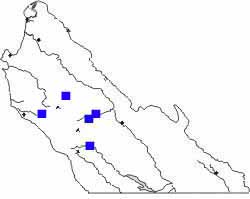| |
|
|
|
SOOTY DANCER
|
|
Argia lugens
|
|
|
|
Sooty Dancer is a large, long-legged
dancer of rushing foothill creeks and rivers. Adult males are almost
entirely covered with a sooty pruinescence that makes them look
all-dark. They also lack the blue-patterned final abdominal segments so
typical of other dancers. There is a pattern of buff-and-black
underlying the sooty pruinescence but even the hints of the pattern can
only be seen at close range (below).
photos (above
& below) 21 Oct 2006 Arroyo Seco River
|
|
|
|
Sooty Dancer perches on rocks, driftwood,
and branches that hang out of the gurgling stream, but rarely anywhere
else. Males flit from rock to log — often not staying in any one place
very long — and can be quite wary.
Photo (right) 5
Aug 2006 Arroyo Seco River
Photo (below) 9 Sep 2006 N
fork, San Antonio River
|
|
|
| Although Sooty Dancer is a distinctive species
once learned, the beginner may confuse a pruinose female Pacific
Forktail for this species. Sooty Dancer is decidedly larger (up to 2
inches long, rather than just an inch long), has longer legs, and has a
very different habitat and behavior. Sooty Dancer is one of those that
is obvious when you actually see it. |
|
|
The male (above) may not yet be fully adult since
we can see much better the complex pattern on the abdomen that will
later become pruinose sooty. Very young males and all females (below)
show a complex pattern of buff-and-black on the thorax.
Photo
(below) 5
Aug 2006 Arroyo Seco River
|
|
|
| In MTY, Sooty Dancer can be rather common and
widespread in summer along the rushing foothill streams of the Santa
Lucia Mountains. It was first collected at Hastings NHR in 1943,
presumably along adjacent Finch Creek. There is also a specimen
collected 50 years ago along the upper Big Sur River. More recently,
the species has been found on various cites on the Arroyo Seco River
and the upper reaches of the San Antonio River. Reports from the
lowlands have yet to be confirmed. |
|
 The map shows the known
locations for Sooty Dancer in MTY to date. All are along fast-running
creeks and rivers in the Santa Lucia foothills. The species likely
occurs throughout the Coast Range in the county on similar streams. The map shows the known
locations for Sooty Dancer in MTY to date. All are along fast-running
creeks and rivers in the Santa Lucia foothills. The species likely
occurs throughout the Coast Range in the county on similar streams.
MTY flight dates so far span 20 May–9 Sep.
Flight dates elsewhere in California range from April-October (Manolis
2003).
|
|
|
Literature cited:
- Manolis, T. 2003. Dragonflies and Damselflies of
California. Univ. of
Calif.
Press, Berkeley.
Web resources:
Major identification web sites with much information on California
odes include:
For sites with excellent photos to compare for identification or to
simply
enjoy, see:
Many of these sites have links to other useful pages. Kathy Biggs's
site
is particularly useful in her selection of links. |
|
All photos © Don Roberson 2007
TOP
|
|
|
Page created 28 Mar 2007,
revised 21 May 2007
|
|
|
|
|
